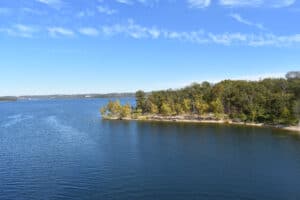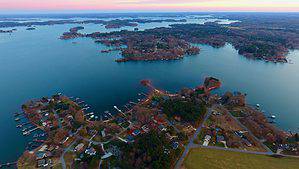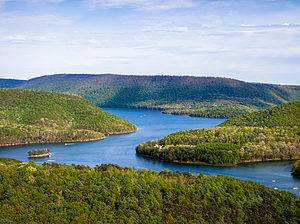If you’ve been to Oregon, you know it’s a natural beauty. Its rugged coastline, breathtaking beaches, rolling dunes, and stormy seascapes make it a haven for outdoor lovers. Other things also contribute to its undeniable charm, including the lush green valleys, high deserts, dense forests, and lovely landscapes. And did you know this state in the Pacific Northwest has over 1,400 lakes? While some are known for their large sizes, others are located in mountainous zones and have gained a reputation for their unrivaled beauty. This article explores the ten most beautiful mountain lakes in Oregon.
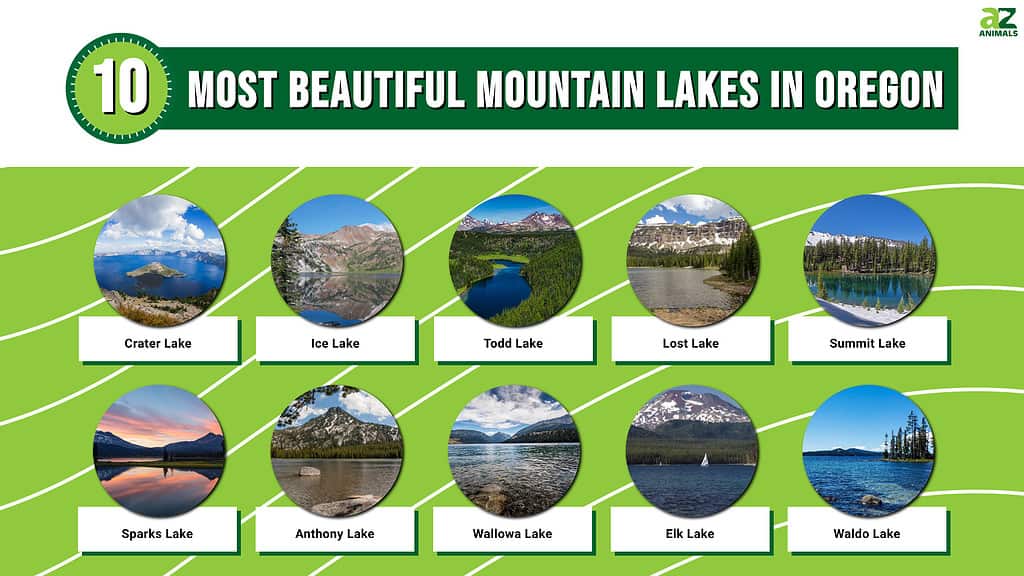
Read on to find essential information about them, including their locations and why they attract locals and tourists alike.
1. Crater Lake
Chances are, when most Americans think of divine lakes, Crater Lake in Klamath County springs to mind. It’s one of the most beautiful mountain lakes in Oregon and the entire country! With a depth of 1,943 feet, it’s the United States’ deepest lake, whose crystal-clear blue water sets it apart from countless others nationwide. Although it’s among Oregon’s snowiest and coldest places, it welcomes more than half a million visitors annually. Thankfully, there are plenty of fun activities for them to enjoy, including biking, hiking, snowshoeing, cross-country skiing, and fishing.
Crater Lake came into existence roughly 7,700 years ago when the 12,000-foot-tall volcano Mount Mazama collapsed to form a massive caldera. After the mountain’s destruction, water filled the depression to create what the world now knows as the clearest lake in Oregon.
Species at Crater Lake
Crater Lake will undoubtedly amaze you if you love nature, especially animals and plants. Its main draw, the Crater Lake National Park, hosts diverse wildlife, such as elk, amphibians, coyotes, bears, birds, and insects. Intriguingly, it’s the only place you can find the endangered Mazama newt and bull trout. Plant lovers will marvel at the many aquatic moss layers in this lake. The mixed conifer forests around it have various trees, including ponderosa pine, whitebark pine, lodgepole pine, and mountain hemlock.
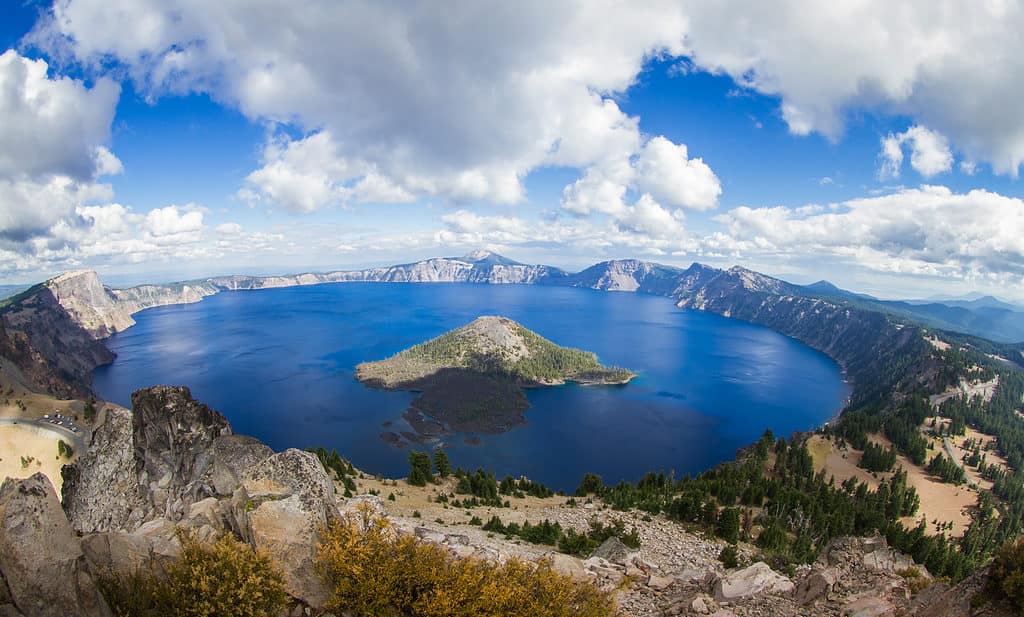
Crater Lake in Oregon is the deepest lake in the United States.
©Wollertz/Shutterstock.com
2. Ice Lake
At about 7,900 feet in elevation and more than 190 feet in depth, Ice Lake is the pride of the Wallowa Mountains, which some call the “Oregon Alps.” Several mountain peaks, each above 9,000 feet, surround this blue alpine lake, including the Wallowas’ tallest ones — the phenomenal marble-topped Matterhorn and Sacajawea.
Ice Lake is a gem for outdoor enthusiasts, with its numerous hiking and backpacking opportunities. Those who trek to the top of the mountain enjoy the most scenic views and are sometimes lucky to spot various wild animals, including:
- Black bears
- Mountain goats
- Deer
- Wolves
Flowers to Find at Ice Lake
A trip to Ice Lake also allows you to discover a wide range of plant species, including beautiful flowers like:
Mariposa Lilies
These are members of the genus Calochortus. They boast three large white petals with long hairs and prominent purple specks in the middle. Because they’re incredibly resilient, these flowers can comfortably survive in hot, dry conditions.
Penstemons
You’re also likely to stumble upon penstemons around Ice Lake. Typically, these stunning perennial plants have foxglove-like flowers that come in many hues, ranging from fiery reds and blues to soft pinks, lavenders, and whites.
Coneflower
Another species you might see during your visit to Ice Lake is the coneflower, a determined member of the daisy family Asteraceae. Most of these flowers are purple, but those with red, pink, orange, yellow, white, and green shades also exist. In addition, the coneflower’s spiky center and powerful scent repel deer, so they don’t eat it.
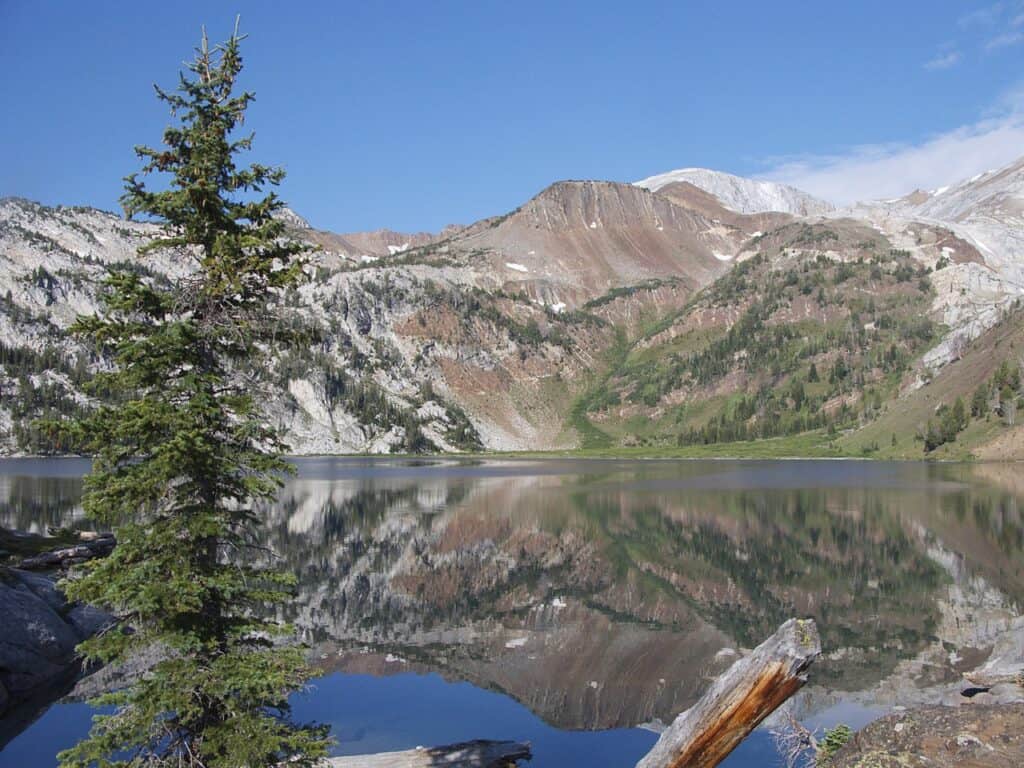
Ice Lake is at an elevation of 7,900 feet.
©mountainamoeba / CC BY 2.0, , via Wikimedia Commons – License
3. Todd Lake
Todd Lake is at the foot of Broken Top, a composite volcano in the vast Cascade Range. Initially, people called it “Lost Lake,” but many mistook it for “Lost Lake” in Oregon’s Mount Hood National Forest, so they changed its name to “Todd Lake” to pay tribute to John Y. Todd, one of the early settlers and cattle ranchers in Central Oregon.
Various trails connect the hill range to Todd Lake, making it a popular destination for hikers. You can also have a fantastic time here if you’re into the following:
- Camping
- Picnicking
- Fishing
- Kayaking
- Nature photography
- Bird watching
- Horseback riding
Plant Life Around Todd Lake
Most plant lovers are fascinated by the plant species surrounding Todd Lake. Mountain hemlock dominates the nearby conifer forest. Still, you’ll easily spot a handful of fir species and lodgepole pine. The ground cover comprises smooth woodrush, side bells, bog huckleberry, larkspur, whortleberry, and Jacob’s ladder. And you should expect to see a large pool of meadow wildflowers, such as alpine aster, Indian paintbrush, swamp laurel, and high mountain cinquefoil.
Animal Life at Todd Lake
The brook trout is the only type of fish known to live in Todd Lake. However, the surrounding regions are home to many animals, including the common garter snake, Pacific giant salamanders, rough-skinned newts, black-tailed deer, cougars, bobcats, raccoons, porcupines, American badgers, and least chipmunks. What’s more, over 160 bird species call this area home.
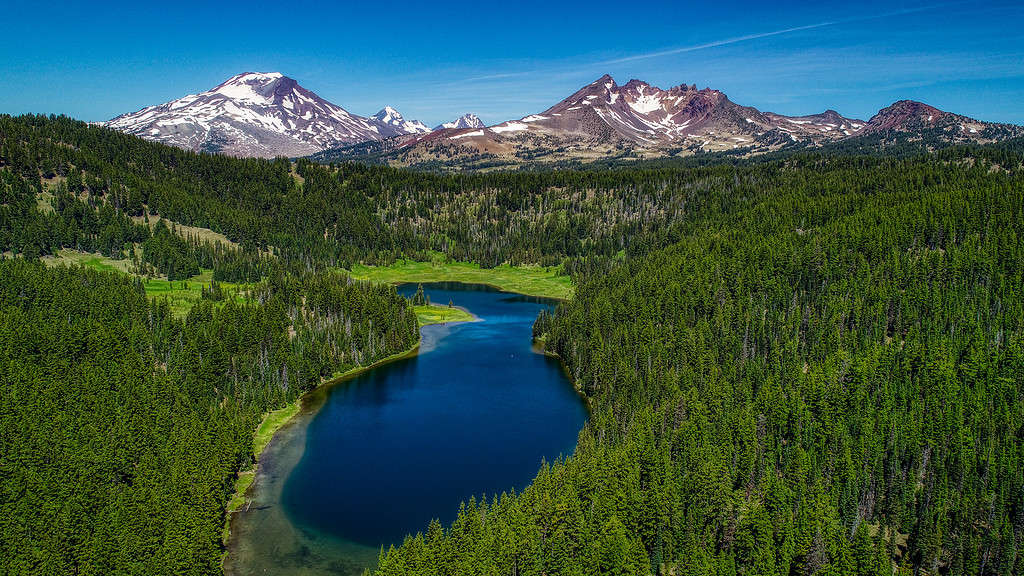
Todd Lake is at the foot of Broken Top, a composite volcano in the vast Cascade Range.
©Cascade Drone Photography/Shutterstock.com
4. Lost Lake
Lost Lake is a breathtaking natural lake sitting at the base of Mount Hood. Because it has a depth of approximately 175 feet, it’s Mount Hood National Forest’s second-deepest lake, right below the 184-foot-deep Wahtum Lake. In addition, three intermittent glacier creeks feed this natural wonder. But the water here is always freezing, even during the hottest summers, owing to its high altitude of over 3,000 ft above sea level.
Due to Lost Lake’s ever-cold water, swimmers visit it to escape the summer heat. Other popular water sports you can enjoy around here include fishing, kayaking, and canoeing. Plus, there are several spots for campers and plenty of trails for hikers and biking enthusiasts.
Plant and Animal Life at Lost Lake
Fish such as kokanee salmon, brown trout, rainbow trout, and brook trout live in Lost Lake. You can also see many wild animals around this body of water — cougars, squirrels, chipmunks, black bears, blacktail deer, and Roosevelt elk. The dense forest mainly comprises mountain hemlock and Douglas fir. Still, there are some cedar and white pine, not to mention huckleberry and alder, mainly in the open areas.
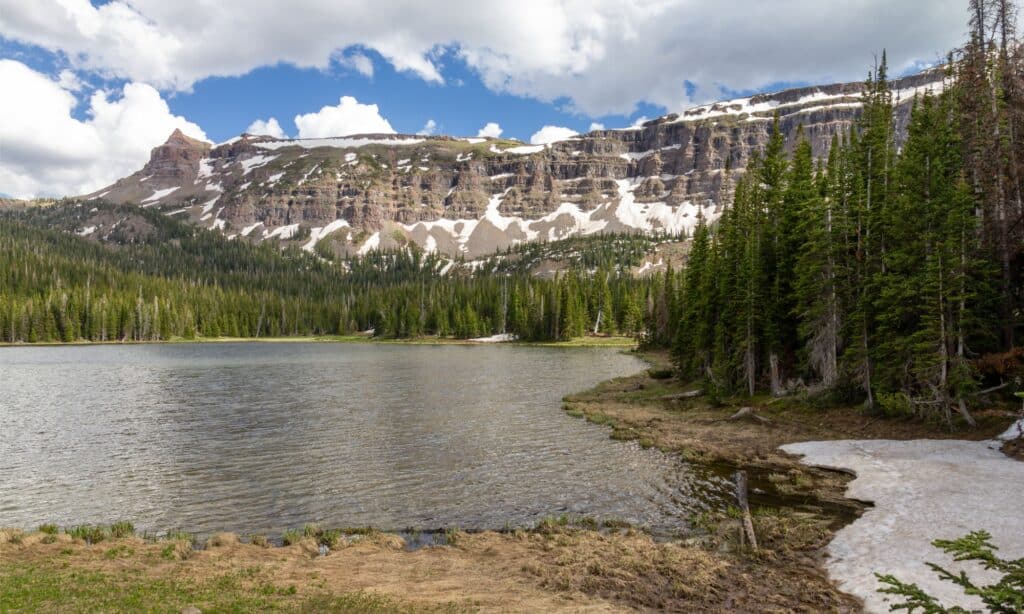
Lost Lake is a breathtaking natural lake sitting at the base of Mount Hood.
©iStock.com/Colophotos
5. Summit Lake
Situated east of Diamond Peak in Lane and Klamath counties, Summit Lake is a small but beautiful mountain lake without any major streams feeding it. Since its water is pure and unbelievably clear, it’s a sight to see any time of the year. Around Summit Lake are many locations for camping, though you can only take advantage of them entirely when the skeeter season ends, usually between November and March.
Watching the sunset is another exciting activity you can engage in at Summer Lake. You can also swim in it, bike, or hike in the surrounding areas as long as you bring the necessary gear. For instance, hikers can wear boots and carry first-aid kits in their backpacks. If you’re looking for some time alone, this could be among your top best locations to visit because it’s uncrowded on most days.
It’s worth noting that other lakes are also known as “Summit Lake” in Oregon. These are in various parts of the state, including Clackamas, Jackson, Jefferson, and Baker counties.
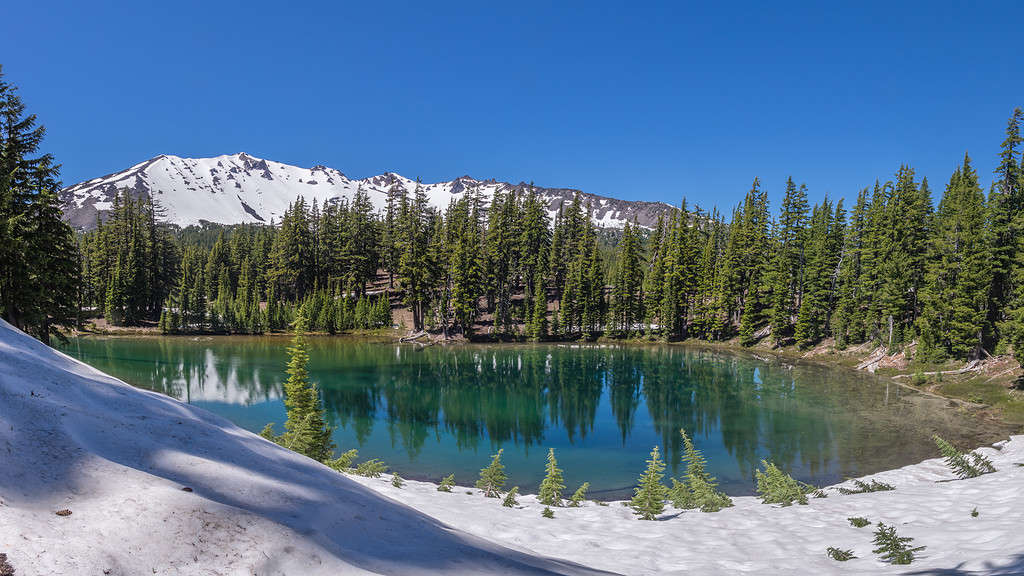
Summit Lake and Diamond Peak, in the Diamond Peak Wilderness, Oregon.
©Peter K. Ziminski/Shutterstock.com
6. Sparks Lake
Famous for its beautiful scenery and charm, Sparks Lake sits roughly 25 miles (40.2 kilometers) from Bend, just off the Cascade Lakes Highway. A ton of cozy beach spots are conveniently sprinkled around the lake’s water edge, from where you can enjoy picturesque views of the Broken Top, Mount Bachelor, and Three Sisters. But there are other reasons to come here; you’ll get many opportunities for many other land and recreational activities like kayaking, canoeing, and camping.
Ideally, Sparks Lake’s water depth is only 7 feet, making it a safe location for boating and swimming enthusiasts. However, because the water temperatures are mostly chilly, you can’t take a dip for too long. Additionally, only fly fishing is permitted at this lake, which hosts considerable populations of cutthroat trout and brook trout. And unfortunately, the list of wild animals living around the water body is short, especially compared to nearby Cascade lakes.
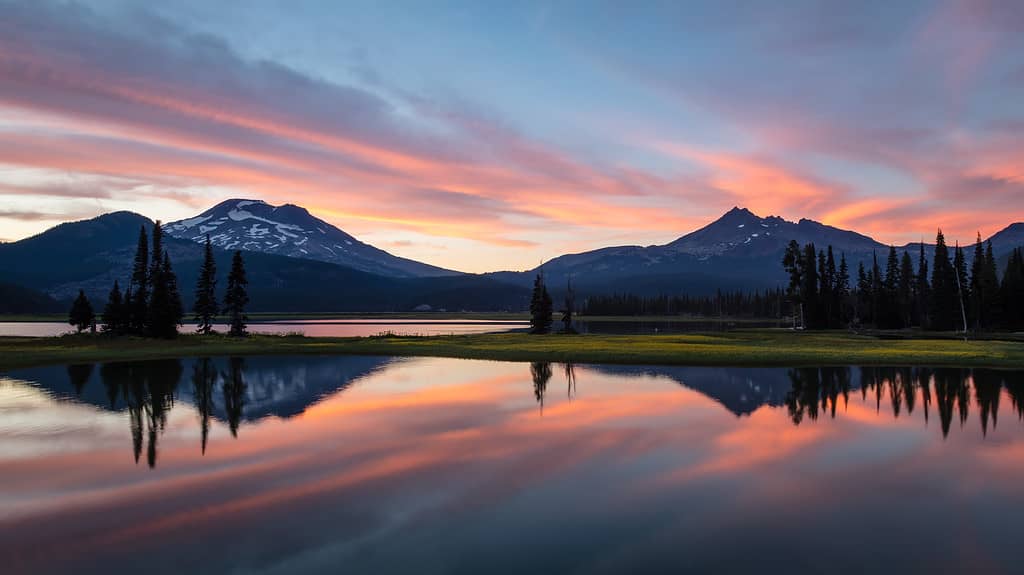
Sparks Lake is famous for its beautiful scenery and charm.
©Sandra Woods/Shutterstock.com
7. Anthony Lakes
Also known as North Powder Lakes, Anthony Lakes is a cluster of about 15 lakes and unnamed marshes in the Blue Mountains. Some of these are:
Grande Ronde Lake
Grande Ronde Lake is a small, high-elevation lake with a remote backcountry vibe, offering camping and picnicking opportunities for visitors. It’s mainly open between June and September, often closing its doors during other months of the year depending on weather conditions. Above it is a picturesque pine-fir forest where you can stroll and bask in nature’s beauty.
Anthony Lake
A popular site for camping and skiing enthusiasts, Anthony Lake is downright beautiful. Every summer, the Oregon Department of Fish and Game stocks it with rainbow trout, and you’ll also find trout in the lake. If you explore the areas around the water body, you’ll see a variety of flowers:
- Monkshood
- Alpine azalea
- Mountain heather
- Lewis monkeyflower
- Hikers gentian
- Penstemons
- Glacier lilies
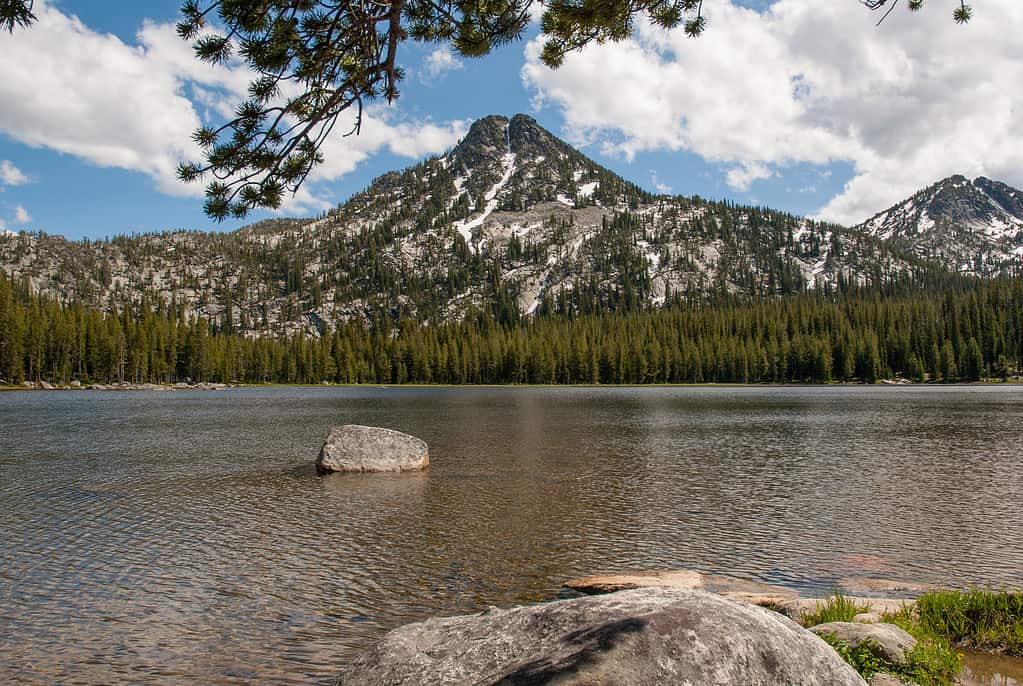
A popular site for camping and skiing enthusiasts, Anthony Lake is downright beautiful.
©Jennifer Bosvert/Shutterstock.com
8. Wallowa Lake
Found at the foundation of the tremendously glaciated Wallowa Mountains, Wallowa Lake has gained fame for many things, including its great visual appeal. With a depth of nearly 300 feet, it’s not the deepest lake in the United States, but it still welcomes thousands of visitors daily. As one of the purest water bodies in Eastern Oregon, the lake makes a fantastic location for sunbathing and swimming, not to mention boating, fishing, and nature watching.
The nearby forested grounds are mainly filled with Ponderosa pine, but some areas have:
- Mountain mahogany
- Aspen
- Grand fir
- Sugar pine
- Western juniper
- Western larch
- Incense cedar
- Lodgepole pine
Wildlife Watching at Wallowa Lake
Discovering Wallowa Lake should be on the bucket list of every animal lover. Some of the many species around here are badgers, black bears, bighorn sheep, chipmunks, Columbian ground squirrels, bobcats, elk, coyotes, cougars, mink, red foxes, pine marten, and snowshoe.
Twilight is the best time to view wildlife at Wallowa Lake since most animals move around then. Of course, you can come to this destination during other hours of the day, but you might miss some interesting species. For example, pine martens are usually active at night in the winter and autumn, making them nearly impossible to spot in broad daylight.
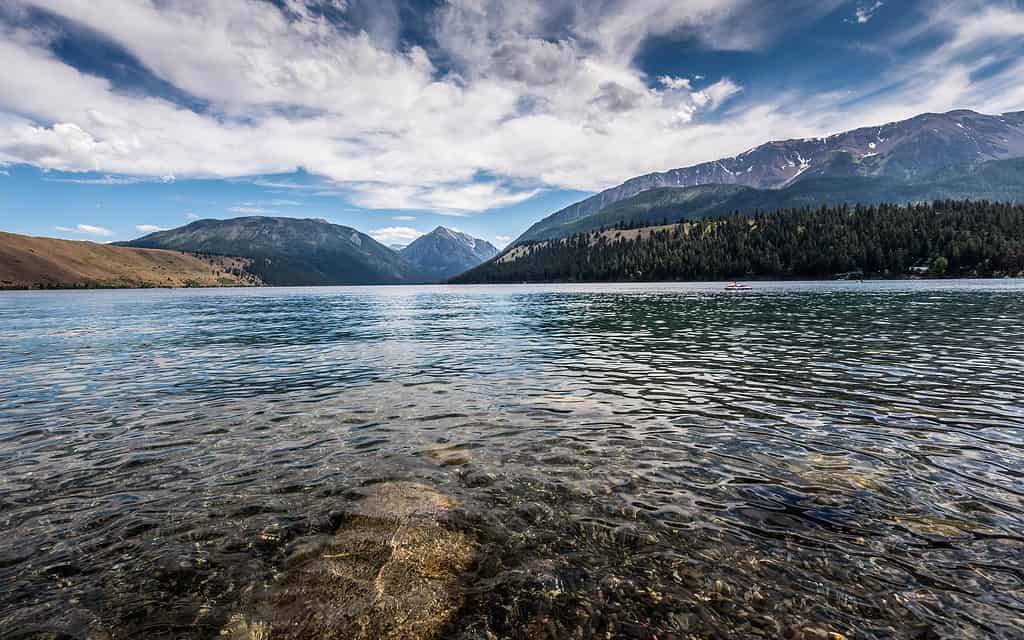
Wallowa Lake has gained fame for many things, including its great visual appeal.
©OLya_L/Shutterstock.com
9. Elk Lake
Located right at the center of the Cascade Range, Elk Lake is a charming body of water almost 4,900 feet above sea level. A vast majority of the people who frequent this pristine destination are watersports enthusiasts interested in swimming, paddleboarding, and windsurfing. While the lake is not particularly popular for anglers, your chances of catching trout are high.
Another of Elk Lake’s major selling points is its pet and family-friendliness. You can bring your kids here to bond and make beautiful memories without necessarily leaving your furry pal at home. Regrettably, visitors are advised to keep their lovely animals out of the water due to its shallowness and sanitation issues.
Camping and Hiking at Elk Lake
So far, Elk Lake boasts 20 campsites, which appeal to many outdoor lovers hoping to spend quality time in the wild. In addition, there are hiking trails around the lake, mainly leading to and from other nearby water bodies, including those around the 85-foot-deep Mint Lake, which sits on roughly 139 acres. Exploring the area allows you to see its diverse vegetation, including wildflowers.
Note that you must reserve a spot at the Elk Lake Campground in advance, lest you miss the opportunity to spend time here. If you’re hiking, you should wear a comfortable and quality pair of sneakers because the terrain is pretty rugged, and you want to be safe and fast at the same time.
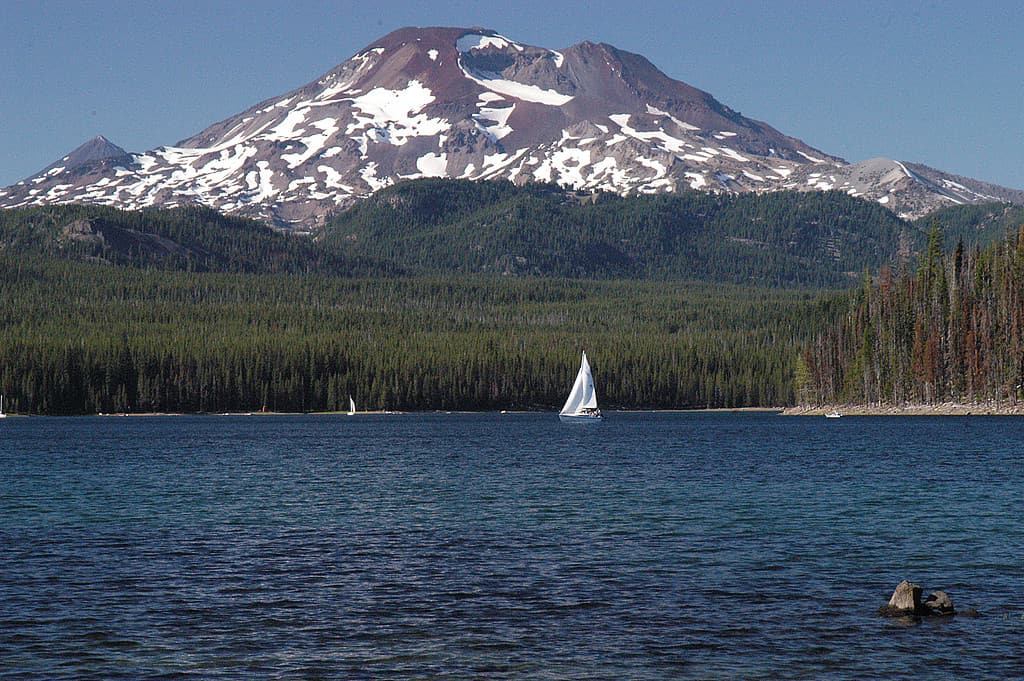
Elk Lake is a charming body of water, almost 4,900 feet above sea level.
©U.S. Forest Service- Pacific Northwest Region / Public Domain – License
1Oregon’s Lake
At about 420 ft in depth, Waldo Lake is Oregon’s second-deepest alpine lake, after the magnificent Crater Lake. It’s found in the Cascade Mountains and is known for its purity, breathtaking beauty, solitude, and many recreational activities for visitors. Its over 200 developed campsites attract Oregonians who mainly flock to this location during the summer months, when they also delight in fishing, boating, and hiking.
Who Inspired Waldo Lake’s Name?
Initially, Native Americans inhabited Waldo Lake, which was named to honor the Oregon State Supreme Court Judge John B. Waldo. Despite his demanding job, he dedicated most of his summers to exploring the Cascades to hunt, fish, and camp, probably to blow off steam. Moreover, Waldo was keen on preserving nature, advocating strongly for the federal forest reserve’s protected animal and plant species. Unsurprisingly, Waldo’s father, Daniel Waldo, was also an expert in the law and served as a legislator in Oregon.
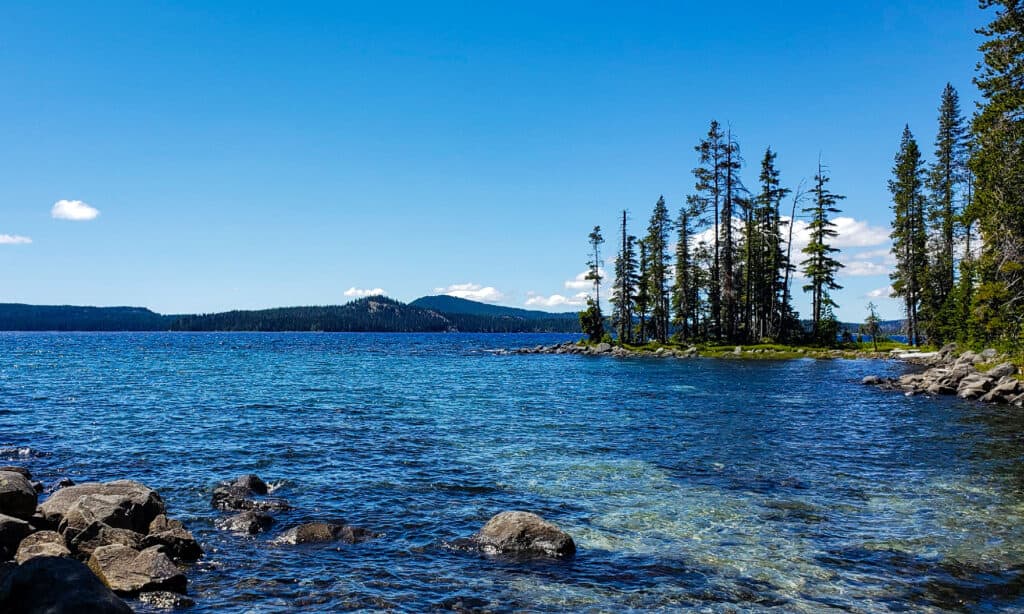
Waldo Lake is a 6,700-acre alpine lake in the Cascade Mountains.
©Amy Bradley MNR/Shutterstock.com
Discover Oregon’s Most Scenic Alpine Lakes
Planning a vacation? Undoubtedly, visiting some of the exotic locations around the world is fun. But nothing beats exploring these ten exquisite lakes spread out across Oregon. With looming mountains, beautiful waters, and gorgeous, sun-filled backdrops, they have that rare soothing effect to calm your nerves and make you happier. Most of them also present opportunities to indulge in a plethora of entertaining outdoor pursuits.
That’s not all. Alpine lakes in Oregon are habitats for various wild animals and plants, which help to maintain a healthy ecosystem. In addition, they supply many neighborhoods with fresh water for sanitation purposes and farming. Even more impressive, these striking water bodies prevent flooding by welcoming excess water to keep nearby communities safe.
The photo featured at the top of this post is © Michal Balada/Shutterstock.com
Thank you for reading! Have some feedback for us? Contact the AZ Animals editorial team.



